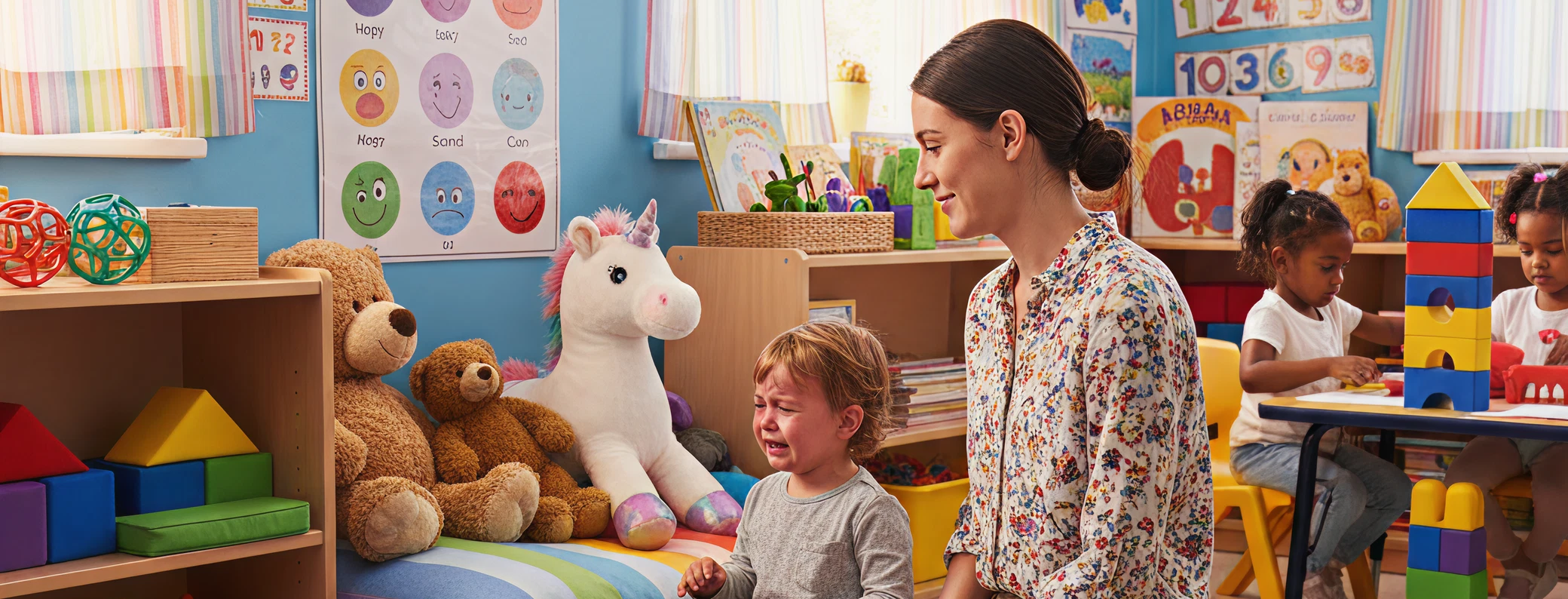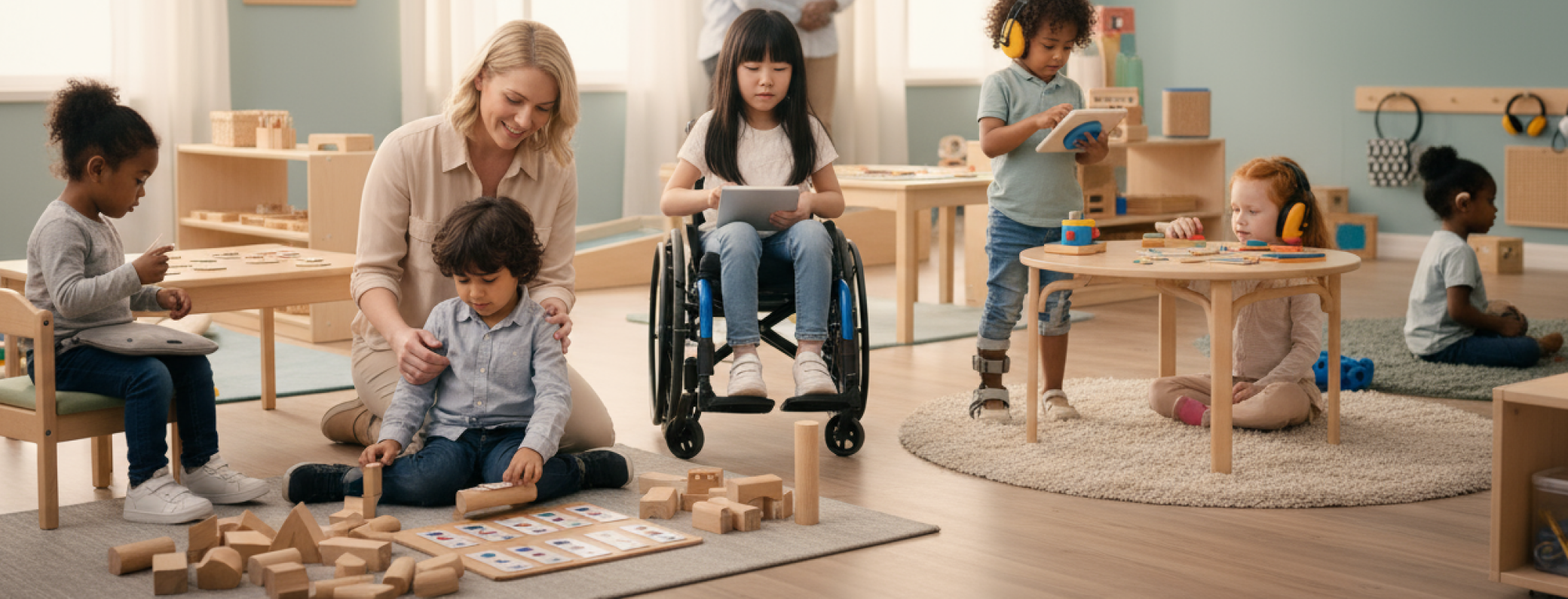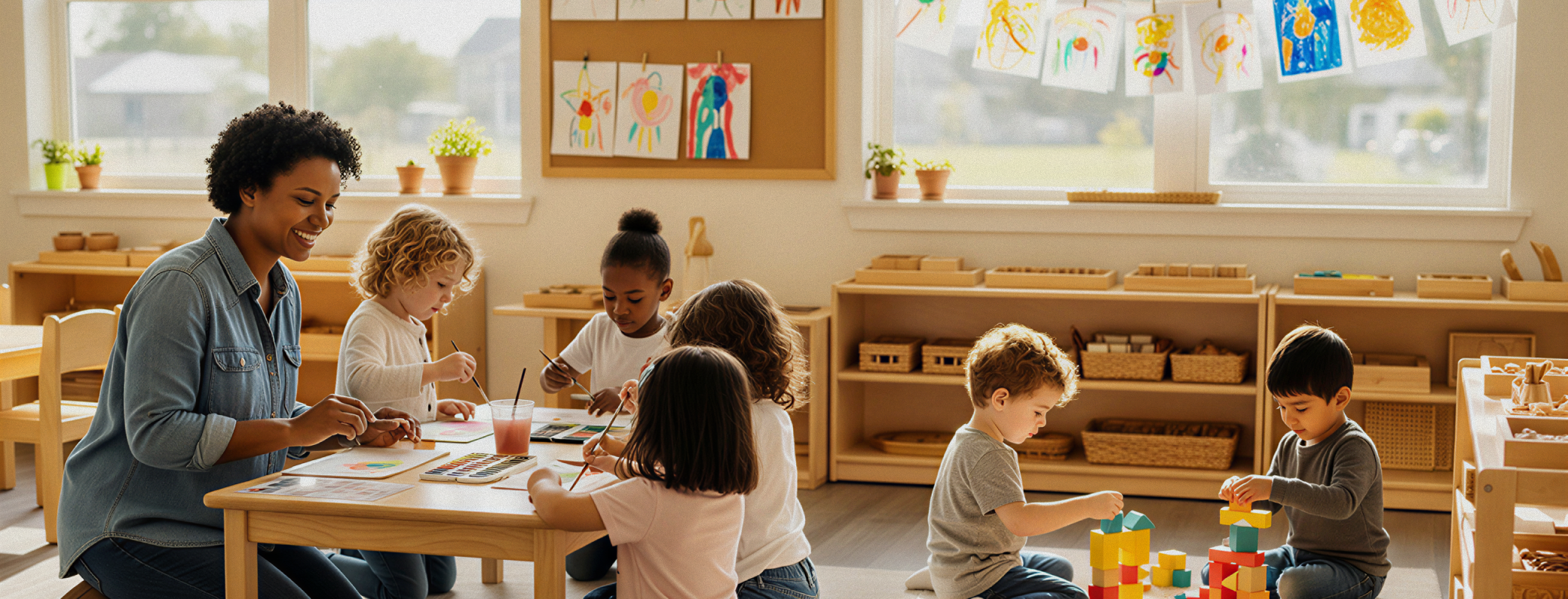Children grappling with emotions that feel enormous in their small bodies aren’t classroom management failures, they're normal expressions. As early childhood educators, we have the privilege and responsibility of helping children develop the emotional regulation skills that will serve them throughout their lives.
The ability to recognize, understand, and manage emotions is one of the most crucial skills we can help children develop. It affects their relationships, learning capacity, physical health, and overall well-being. Yet many of us received little training in supporting emotional development, leaving us to figure out responses in the moment while managing full classrooms of children with diverse emotional needs.
The good news is that emotional regulation is a skill that can be taught, practiced, and strengthened over time. With intentional strategies and consistent support, we can help children move from being overwhelmed by their emotions to becoming confident managers of their inner experiences.
Understanding Emotional Development in Young Children
Before we can effectively support children's emotional regulation, we need to understand what's happening developmentally and why big emotions are both normal and necessary for healthy growth.
The Developing Brain and Emotional Control
Young children's brains are still developing the neural pathways necessary for emotional regulation. The prefrontal cortex, which controls executive functions like impulse control and emotional regulation, doesn't fully mature until the mid-twenties. This means that preschoolers are literally incapable of managing emotions the way adults expect them to.
When a child has a big emotional reaction, their amygdala (the brain's alarm system) is activated, triggering fight, flight, or freeze responses. During these moments, the logical, thinking parts of their brain go offline, making it impossible for them to "use their words" or "make good choices" until they feel safe and regulated again.
Understanding this brain science helps us respond with empathy rather than frustration when children struggle with emotional control. It also emphasizes the importance of helping children develop regulation skills gradually, with plenty of support and practice.
Emotional Expression as Communication
For children, emotions serve as their primary communication system about their internal experiences and needs. A meltdown about a broken crayon isn't really about the crayon, it might be about feeling powerless, experiencing disappointment, or being overwhelmed by accumulated stress.
When we view emotional expressions as communication rather than misbehavior, we can respond more effectively by addressing underlying needs rather than just surface behaviors. This approach builds trust and teaches children that their emotions are valid and manageable.
Individual Differences in Emotional Processing
Children vary dramatically in their emotional sensitivity, processing styles, and regulation strategies. Some children are naturally more emotionally reactive, while others internalize their feelings. Some need movement to regulate, while others need quiet space. Some process emotions quickly, while others need extended time to work through feelings.
Recognizing these individual differences helps us tailor our support strategies to each child's unique needs rather than applying one-size-fits-all approaches that may not be effective for all learners.
Creating Emotionally Safe Classroom Environments
The foundation of emotional learning lies in creating environments where children feel safe to experience and express their full range of emotions without fear of judgment or rejection.
Establishing Emotional Safety
Emotional safety means that children know their feelings will be accepted and supported, even when their behavior needs guidance. This requires consistent, warm responses to emotional expressions and clear separation between accepting feelings while setting limits on harmful behaviors.
Create predictable routines and clear expectations that help children feel secure and know what to expect. When children feel safe in their environment, they're better able to take the emotional risks necessary for growth and learning.
Develop consistent language around emotions that normalizes the full spectrum of human feelings. Avoid phrases like "don't be sad" or "you're fine" that invalidate children's experiences. Instead, use language like "I see you're feeling frustrated" or "It's okay to feel disappointed when things don't go the way we hoped."
Physical Environment Supports
Design your classroom with emotional regulation in mind. Create quiet spaces where children can retreat when feeling overwhelmed. These might include cozy reading corners with soft pillows, small tents or canopies, or designated calm-down areas with sensory tools.
Ensure your environment includes materials that support emotional regulation: stress balls, fidget toys, weighted lap pads, soft fabrics, or sensory bottles. These tools should be available to all children as supports rather than consequences.
Consider the sensory aspects of your environment that might contribute to emotional overwhelm. Adjust lighting, reduce noise levels when possible, and create visual organization systems that help children feel oriented and in control of their space.
Building Emotional Vocabulary
Young children often lack the vocabulary to express their complex emotional experiences, leading to behavioral expressions of feelings they can't name. Systematically building emotional vocabulary gives children tools for communication and self-understanding.
Use emotion words throughout daily interactions, not just during conflicts. "I notice you look excited about that puzzle" or "You seem disappointed that story time is ending." This ongoing narration helps children connect internal experiences with language.
Read books that explore emotions and discuss characters' feelings and coping strategies. Use emotion faces, feeling charts, or emotion cards as visual supports for children who are still developing verbal expression of feelings.
Evidence-Based Strategies for Supporting Emotional Regulation
Research provides clear guidance on effective approaches for helping young children develop emotional regulation skills through supportive teaching practices.
Co-regulation as the Foundation
Co-regulation involves adults helping children regulate their emotions by providing external support that children will eventually internalize. This is the foundation of emotional learning, children learn regulation through experiencing it with supportive adults.
During emotional moments, focus first on your own regulation. Children pick up on adult emotional states, so modeling calm, steady energy helps children feel safer and more able to regulate themselves. Use slow, deep breathing and calm, low vocal tones to create a regulating presence.
Provide physical comfort when appropriate and welcomed by the child. This might include sitting nearby, offering a hug, or simply staying present while the child works through their emotions. Your calm, accepting presence is often more powerful than words.
Teaching Emotional Awareness
Help children develop the ability to recognize and name their emotions as they occur. This metacognitive awareness is the first step in learning to manage emotional experiences effectively.
Use emotion coaching techniques that acknowledge feelings while providing guidance. "I see you're feeling angry because your friend took your toy. Anger is a normal feeling when something feels unfair. Let's think about what you can do when you feel angry."
Help children notice the physical sensations that accompany different emotions. "When you feel frustrated, you might notice your hands getting tight or your stomach feeling funny. These are clues that your body is telling you about your feelings."
Create opportunities for children to reflect on emotional experiences after the intensity has passed. "Earlier today you were really upset about cleanup time. How are you feeling now? What helped you feel better?"
Breathing and Mindfulness Techniques
Teach simple breathing techniques that children can use independently to support their regulation. Deep breathing activates the parasympathetic nervous system and helps children move out of fight-or-flight states.
Make breathing exercises playful and engaging for young children. Try "flower breathing" (smell the flower, blow out the candle), "balloon breathing" (inflate and deflate an imaginary balloon), or "bunny breaths" (three quick sniffs and one long exhale).
Introduce simple mindfulness activities that help children tune into their present moment experience. This might include guided body scans, listening activities, or mindful movement exercises that build awareness and self-regulation skills.
Problem-Solving and Coping Strategies
Once children have developed basic emotional awareness, help them build a toolkit of strategies for managing difficult emotions. These strategies should be practiced during calm moments so they're available during emotional challenges.
Teach children to identify what triggers their big emotions and develop personalized coping plans. Some children might need movement breaks, while others need quiet time. Some might benefit from drawing or talking, while others need sensory input or physical comfort.
Practice problem-solving skills during calm moments through role-play, storytelling, and hypothetical scenarios. "What could you do if someone took your toy?" or "How might you handle it if you felt scared during loud noises?"
Responding to Emotional Outbursts in the Moment
When children are in the midst of big emotions, our immediate responses can either escalate the situation or provide the support needed for regulation and learning.
The Power of Validation
Validation doesn't mean agreeing with all behaviors, but rather acknowledging that the child's feelings make sense given their experience and developmental level. This validation helps children feel understood and reduces the intensity of emotional reactions.
Use phrases like "You're really upset right now" or "This feels really big for you" rather than trying to minimize or fix the emotion immediately. Validation often helps children move through emotions more quickly than attempts to distract or redirect.
Avoid asking "why" questions during emotional moments, as children in fight-or-flight states can't access the rational thinking needed to explain their reactions. Focus instead on acknowledging what you observe and providing support.
Staying Present Through the Storm
Resist the urge to rush children through their emotions or make them stop crying immediately. Emotions need to be felt and processed, and this takes time. Your steady, calm presence communicates that emotions are manageable and that you're a safe person to experience feelings with.
If a child needs space during an emotional moment, respect that need while staying nearby and available. Some children regulate better with physical closeness, while others need room to move or be alone before they're ready for connection.
Continue to offer comfort and support even if it's initially rejected. Children in emotional distress may push away help initially but often return to accept support once they feel slightly more regulated.
Teaching in the Moment
While children in full emotional meltdown can't access learning, there are teachable moments as they begin to regulate. Help children notice what's happening in their bodies, what helped them feel better, or what they might try differently next time.
Use these moments to reinforce coping strategies: "I noticed when you took those deep breaths, your body started to feel calmer" or "Using your words really helped your friend understand what you needed."
Connect current experiences to previous successes: "Remember yesterday when you felt frustrated and you asked for help? You used that same strategy today, and it worked!"
Building Long-Term Emotional Resilience
The goal of emotional support isn't to eliminate challenging emotions but to help children develop the skills and confidence to navigate life's inevitable emotional challenges successfully.
Developing Emotional Intelligence
Emotional intelligence involves understanding emotions in ourselves and others, using emotional information to guide thinking and behavior, and managing emotions effectively. These skills develop gradually through supportive relationships and intentional practice.
Help children recognize emotions in others through books, dramatic play, and real-life observations. "How do you think Maya is feeling when her face looks like that?" or "What do you notice about Carlos's body that tells you something about his feelings?"
Practice perspective-taking through storytelling and hypothetical scenarios. This helps children understand that different people might feel differently about the same situation and that multiple emotional responses can be valid.
Teaching Self-Advocacy Skills
As children develop emotional awareness and regulation strategies, help them learn to advocate for their own needs. This might include asking for breaks when feeling overwhelmed, requesting help when emotions feel too big, or communicating their needs clearly to peers and adults.
Create systems that make self-advocacy easier, such as visual cues children can use to request help, designated spaces they can choose for regulation, or simple phrases they can use to communicate their emotional state.
Celebrate children's growing independence in emotional management while continuing to provide support as needed. The goal is gradual release of responsibility as children demonstrate increasing capability.
Building Connections Between Emotional and Social Skills
Help children understand how their emotional management affects their relationships and social interactions. This isn't about suppressing emotions to please others, but rather about understanding how emotional regulation supports positive connections with peers and adults.
Practice social problem-solving that takes emotions into account: "When you feel angry with your friend, what are some ways you could handle that feeling that would help keep your friendship strong?"
Use conflicts and social challenges as opportunities to practice emotional regulation in real contexts. Support children in working through disagreements while managing their own emotions and considering others' feelings.
Working with Families to Support Emotional Development
Consistency between home and school environments significantly enhances children's emotional learning and regulation development.
Sharing Strategies and Insights
Communicate regularly with families about children's emotional development, sharing both challenges and successes. Help families understand that emotional learning is a normal part of development that requires patience and consistent support.
Share specific strategies that work well for individual children at school, and ask families about approaches that are effective at home. This exchange of information helps create consistent support across environments.
Provide families with resources for supporting emotional development at home, including book recommendations, activity suggestions, and information about normal emotional development in young children.
Addressing Different Approaches
Recognize that families may have different cultural values and approaches to emotional expression and regulation. Work collaboratively to understand family perspectives while sharing research-based practices that support healthy emotional development.
Help families understand the difference between supporting emotional regulation and suppressing emotional expression. Some families may worry that acknowledging children's emotions will make them "soft" or unprepared for life's challenges.
Provide information about the long-term benefits of emotional intelligence and regulation skills, including academic success, relationship quality, and mental health outcomes.
Supporting Families' Emotional Regulation
Remember that parents and caregivers are also learning to manage their own emotions while supporting their children's development. Provide resources and support for adult emotional regulation, recognizing that children learn primarily through modeling.
Offer understanding and support for families who may be struggling with their own emotional challenges or trauma histories that affect their ability to support their children's emotional development.
Connect families with additional resources when needed, including mental health services, parent education programs, or support groups that focus on emotional wellness and parenting skills.
Professional Development and Self-Care
Supporting children's emotional development requires ongoing attention to our own emotional awareness, regulation skills, and professional growth.
Developing Your Own Emotional Awareness
Reflect on your own emotional triggers and responses, particularly those that arise in challenging moments with children. Understanding your own emotional patterns helps you respond more thoughtfully rather than reactively.
Practice your own emotional regulation strategies and model the skills you're teaching children. This authenticity makes your teaching more powerful and helps you remain regulated during children's emotional storms.
Seek support for your own emotional wellness through professional development, therapy, peer consultation, or other resources that help you maintain emotional balance in demanding work.
Building Team Capacity
Work with colleagues to develop consistent approaches to emotional support across your program. This includes shared language, common strategies, and unified responses to challenging behaviors.
Engage in regular reflection and problem-solving with colleagues about specific children and emotional challenges. Different perspectives and shared brainstorming often lead to breakthrough insights and strategies.
Provide mutual support during difficult days and celebrate successes in helping children develop emotional skills. This work can be emotionally demanding, and team support is essential for sustainability.
Staying Current with Research
Continue learning about emotional development, trauma-informed practices, and evidence-based interventions through professional development opportunities, reading, and conference attendance.
Stay informed about cultural considerations in emotional development and regulation, recognizing that emotional expression and regulation strategies vary across cultures and communities.
Connect with mental health professionals who can provide consultation and support for children with more intensive emotional needs that may require specialized intervention.
Measuring Progress and Celebrating Growth
Emotional development is often gradual and subtle, making it important to document and celebrate progress systematically.
Observational Documentation
Keep records of children's emotional development, including their growing vocabulary for feelings, increased use of coping strategies, and improved ability to recover from emotional upset.
Document specific examples of emotional growth, such as a child asking for help instead of melting down, using breathing techniques independently, or showing empathy for a peer's distress.
Note patterns in emotional triggers and successful regulation strategies for individual children, using this information to refine your support approaches and communicate with families.
Portfolio Development
Include examples of children's emotional learning in their portfolios through photos, artwork, dictated stories about feelings, or documentation of social problem-solving successes in the Parent App.
Create visual documentation that shows children's emotional growth over time, such as before-and-after examples of how they handle similar challenging situations.
Use portfolio materials to help children reflect on their own emotional growth and recognize their developing capabilities in managing feelings.
Celebrating Emotional Milestones
Acknowledge and celebrate emotional development milestones just as you would academic or physical achievements. This reinforces the importance of emotional skills and motivates continued growth.
Help children recognize their own progress by reflecting together on their growing emotional capabilities. "Remember when you started school and loud noises felt scary? Look how you handle fire drills now!"
Share successes with families, helping them recognize and appreciate their children's emotional development and the skills that will serve them throughout life.
Creating Lasting Impact
The emotional regulation skills children develop during their preschool years create ripples that extend far beyond the classroom. Children who learn to understand and manage their emotions are better prepared for academic challenges, more successful in relationships, and more resilient in facing life's inevitable difficulties.
When we approach emotional development with the same intentionality we bring to literacy or math instruction, we help children build the foundation for lifelong wellness and success. Every moment we spend helping a child work through frustration, teaching breathing techniques, or validating feelings is an investment in that child's future emotional health.
The children in our classrooms who struggle with big emotions aren't broken or difficult, they're learning one of life's most important skills. Our patient, skilled support during these learning moments helps them develop the emotional intelligence that will serve them as students, friends, partners, parents, and community members throughout their lives.
As early childhood educators, we have the profound privilege of helping children navigate their emotional worlds with compassion, skill, and understanding. We contribute to raising a generation that's better equipped to handle life's challenges and build positive relationships with others.
The strategies and approaches outlined here represent best practices grounded in developmental science and proven effective in real classrooms with real children. Implementing them consistently requires patience, practice, and commitment to our own emotional growth. Seeing children develop confidence in their ability to handle life's ups and downs makes this some of the most meaningful work we can do as educators.
Billing, Invoicing Automation & Smart Finances
Communication & Engagement
Child Development & Progress
Waitlist, Forms & Attendance
Effortless Team Management
Daily Updates That Matter
Templates & Printables
Blogs
Webinars
Case Studies & Testimonials
FAQs
Help Center




